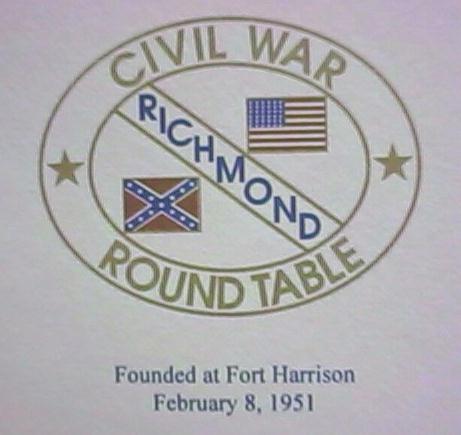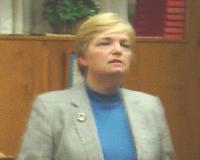


November 2004
rcwrt.org
First Vice President: Rob Monroe, Editor Richard Forrester 2416 Edenbrook Dr. Second Vice President: Richmond, VA 23228-3040 Shep Parsons rmonroe@richmond.com
November 2004 PROGRAM Dr. Taylor Saunders, "Lee as President of Washington College" 8:00 p.m., Tuesday, November 9, 2004, at the Willow Oaks Country Club 6228 Forest Hill Avenue 6:00 Social 7:00 Dinner 7:45 Featured Speaker Dr. Taylor Saunders was reared in Richmond and did his undergraduate and graduate work at Centre College and the University of Virginia. He joined the Washington & Lee faculty in 1969 and was named W&L's university historian in 1973. At W&L he has taught classes in American and ancient European history and in the classics. He has written two books, chapters for several others, and half a dozen monographs. His numerous reviews and articles have appeared in publications ranging from The Virginia Magazine of History and Biography to The Old Farmer's Almanac and is a contributor to The Encyclopedia of Southern Culture. In addition to participating in numerous Civil War tours and seminars, he recently completed a three-year term as the Virginia Society of the Cincinnati's Distinguished George Washington Scholar. Much of Dr. Saunders' teaching, writing and research deals with ancient history. He has lectured in the UK, Italy, Greece, Egypt and on the Island of Rhodes. He recently conducted seminars in Damascus, Sleppo, and Palmyra, Syria. He will discuss Gen. Robert E. Lee at Washington College (1865-1870). Dr. Saunders believes that Lee lived up to at least one journalist's hopes that he would shake up "old fogy" academicians in the way he had shaken up "old fogy" generals.
Recap of October Program
 |
Exhibit to End Soon
Widely known for its outstanding historic military collection, The Museum of the Confederacy displays the depth of its domestic/homefront collection in The Confederate Nation, an exhibit that asks the question: To what degree did the Confederacy demonstrate the unity and purpose to make a nation? The original Great Seal of the Confederacy, and a colorful variety of Confederate state and local currency, along with many rare personal artifacts tell the stories of this fledgling nation and of the diverse Southern people. Never before exhibited to the public, the ten-foot-long original handwritten Constitution of the Confederate States has been a constant source of visitor fascination. Because of the constitution's condition and size, the museum had to have a special case constructed to display it in the special exhibit area. Since no other display area can currently accommodate it, this prized document will be retired to storage when the exhibit ends. Throughout The Confederate Nation, visitors encounter the faces of Southerners - men and women, white and black - staring from original velvet-lined cased-image photographs. Some show ordinary people whose names are not familiar - widows, young soldiers bound for the front, nurses - while others' names ended up in history books. Poster-sized reproductions of historic MOC photographs show young couples, children playing in front of the ruins of buildings in Charleston, S.C., and women in mourning who seem to walk hurriedly through the Burned District of downtown Richmond. Visitors see the simplest of homemade shoes fashioned from raccoon skin, mourning dresses and jewelry, symbols of Confederate patriotism from patriotic aprons to silk First and Second National flags, as well as evidence of Southerners who never surrendered their loyalty to the Union. Younger visitors are drawn to Nina and Lucy Ann, two large dolls, who testify to a citizenry under siege and struggling with privation: the heads of both dolls were used to smuggle quinine into the South. Although the exhibit cannot answer all the questions that scholars continue to debate, the many fascinating objects and images on display illuminate facets of Confederate nationalism and the diverse reactions of the Southern people to the trials of war and ultimate defeat. The exhibit invites visitors to consider timely questions about nation-building in time of war. The Confederate Nation exhibit closes Monday, Jan. 3, 2005. The Museum of the Confederacy will unveil a new special exhibit on the Confederate Navy in early March 2005.
Upcoming Events
Thursday, November 11 Special Veterans Day program saluting black Union troops from Tidewater who fought at Petersburg, Suffolk and New Market Heights. 11:30am-2pm at the Gabriel Chapel AMEZ Church, 2216 Long Ridge Road in Chesapeake. Free. Info: 757-547-5542.
Saturday, November 13 Living history at Hallsbrough Tavern, 16300 Midlothian Turnpike, just west of Route 288 intersection. 11am-5pm. Features the 15th Virginia Infantry and Richmond citizens. Info: www.15thvacoa.org
Saturday and Sunday, November 20-21 Civil War Show at Richmond Raceway Complex. Co-sponsored by the Central Virginia Civil War Collectors Association and the Museum of the Confederacy. Several hundred exhibitors.
Monday, December 6 Holiday Music Program at Old Salem Church on Route 3 west of Fredericksburg. 7pm. Free. Info: www.nps.gov/frsp
Sunday, December 12 Court End Christmas Celebration, noon - 5pm. The Museum and White House of the Confederacy, Valentine Richmond History Center, Historic Richmond Foundation's Monumental Church, John Marshall House, and the Virginia State Capitol will offer free admission all day and will have activities ranging from musical performances and special house tours to children's activities and costumed interpreters. Free, guided tour of the White House of the Confederacy, decorated for the season as it was when Jefferson Davis and his family lived there.
RCWRT Monthly Speakers for 2004
Newsletter Deadlines To facilitate the printing and timely distribution of the monthly newsletter, information for it should be submitted to the editors no later than the following dates: December newsletter December 3 Information may be emailed to rmonroe@richmond.com
Richmond Civil War Round Table Newsletter Rob Monroe, Editor 2416 Edenbrook Dr. Richmond, VA 23228-3040
Return to News Letters Index
Return to main page

©R.C.W.R.T. 2004